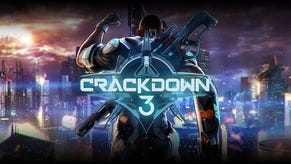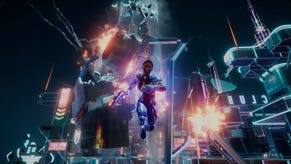Crackdown 3 review: the series' simple genius remains elusive
Good for justice, bad for your health.
There are two kinds of simple, I think. There's so simple that anybody can do it, and then there's so simple that nobody else will be able to do it ever again.
Weirdly, I reckon the first kind of simple is exemplified by panna cotta. This wobbling, pearl-skinned marvel seems so rarified and delicate that, on initially reading the ingredients list, the whole thing seems like a huge Italian prank. Milk, gelatine, a bit of cream and sugar? But I paid £9.95 for this in Covent Garden. And, listen, people are so impressed when you make it for them! In truth, though, with milk, gelatine, and a bit of cream and sugar, it would be harder to walk away from that scenario without making panna cotta. All over Rome, the party lines are buzzing with whispered confessions: it's so simple. IKR. It's harder to make the coulis.
For the second kind of simple, I'm tempted to say Charlie Brown's head, but I fear I've used this analogy before. No matter. Grab a piece of paper and a pen and try and draw Charlie Brown's head. Take your time. How did that go? He looks like a thug, right? Or a halloween pumpkin that's been through a trash compactor? Charlie Brown's head looks like it should be a cinch, but the Peanuts gang are all various degrees of incredible difficulty. Even Schulz himself would grow woozy with malice when a fan wrote in and asked him to knock out a quick Schroeder - and it wasn't the piano that made it so tricky.
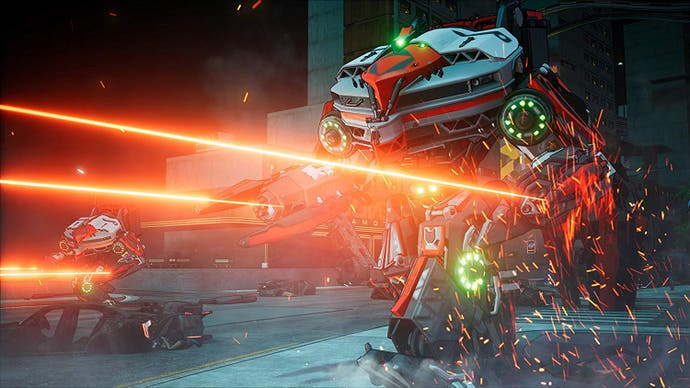
All of which lands us on Crackdown, a game that seems even more implausibly straightforward than panna cotta. Truly, on the Italian Desserts Continuum - thanks to Niki Segnit for this; Lateral Cooking is a total banger - Realtime Worlds' aging classic wouldn't even trouble biscotti. Man, this stuff seems straightforward: a super-cop fighting off waves of criminal gangs in a city where every one of his actions rewards him by making him even better at doing the thing he was already doing. Shoot your gun and you get so much sharper at shooting guns. Do a flip in a car or explode a lorry and your car-flipping and lorry-exploding skills go through the roof. It's almost a parody of RPG progression, almost a sarcastic, pared-back satire of the reeling Katamari-like mindlessness of it all. And yet it works, not least because the city is the world's greatest adventure playground, in which you leap and grasp and fling yourself through the air, finding glowing green orbs - which make you better at leaping, grasping and flinging, naturally, and which also compete with the business of tracking down a handful of big-ticket criminals to become the game's true guiding objective.
So simple, and yet nobody has quite been able to rework the magic. I liked Crackdown 2 more than most at the time, and I appreciate the constraints the developers were under, but I'll admit I have never been back since. The introduction of things that felt a bit like MMO live events - with huge baddies and progress bars doing something or other - added just a little too much structure to a game that had always thrived on the heady, high-altitude goofiness of near-total freedom. Equally, pretenders like Prototype and Infamous came along, both blending in DNA from their developers' own back catalogue, but - and we're back to recipes here, I must be hungry today - too much of one ingredient called for adjustments elsewhere. If you can run up the side of a building no messing, then the combat had better be a bit more involved. If you have electrical superpowers that allow you to race across the environment in crackling bursts, maybe a morality system or, even worse, a story, will keep you grounded. Meanwhile, absolutely everybody in open-worlds had a crack at the orbs, and nobody got it right.
All of which means Crackdown 3 was up against it even before it entered a protracted development that saw teams shift around and Big Ideas relegated to multiplayer modes. I feel for the people working on Crackdown 3, because the problem is suddenly twofold: how do you recapture such simple magic? And then how do add something else that makes it even more magical? Reader, I would sooner draw Charlie Brown's head.
Let's deal with the Big Idea first. The early dream of a Crackdown 3 set in a fully destructible city has been transformed into a multiplayer suite called Wrecking Zone, in which you play variations on team deathmatch and one of those area-capturing modes. Both are initially entertaining enough thanks to Crackdown's focus on gymnastic movement across vertical spaces. Both drag on too long, however, and devolve into meter-watching as the two teams battle out without much in the way of genuine drama.
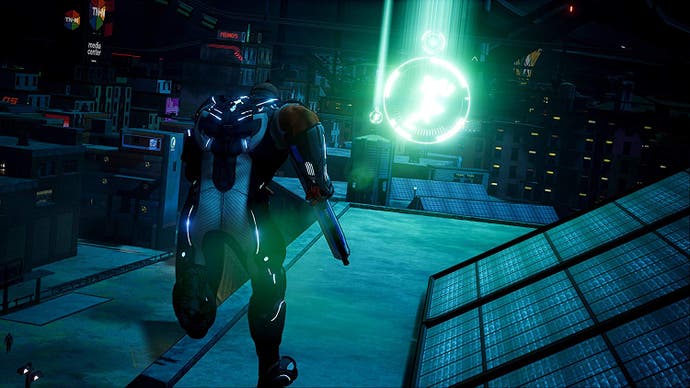
The key feature, the fact that you can reduce the landscape to rubble as you play, feels like a technical showcase, which, sadly, in this instance means that it isn't a huge amount of fun. It's neat to blast away at walls early on, but such is the paceless formlessness of most matches that nothing tactical ever really emerges from your new powers. Equally, and this is often the case with strange video game physics, the slightly artificial way in which walls cave and crumble leaves your unconscious mind reaching for a real-world parallel. Again, sorry to go with the cooking stuff, but Wrecking Zone feels a bit like rampaging through a French Patisserie and punching slabs of meringue into powder. Fun enough, I guess, but I'm not sure I want to do it every evening. Also it misses a fundamental point: Crackdown's about mastering the environment, not reducing it to gravel.
The story campaign is much more interesting, partly, and I hate to say this, because it's been trickier for me to untangle why I wasn't having much fun with it. On the surface it all looks great. Sumo, a genuinely wonderful developer, has built an entirely new city to play in, and New Providence really seems the part, outer rings of slums and industrial pits threaded through ramped super-highways and circling a range of stilted super-scrapers. The whole thing is then covered with garish splinters and splatters of three-dimensional light, obscuring the grim faces of the buildings themselves and beckoning you into the kind of gloriously ugly 1980s padded-VHS-video-case futurism that games like Crackdown and XCOM have always been so good at evoking - the kind of games that tune into the future of Robocop rather than Star Trek.
Against this backdrop all number of tweaks have been made. You still level up by doing the same things as before - getting better at shooting by shooting, getting better at jumping by going after those orbs - but the process has been given a bit of texture, one agility level giving you an air-dash, say, or a jump, double-jump, or double-air-dash. Equally, the three takes on the Batmobile that the first Crackdown delivered have been transformed into a morphing agency vehicle that can be a supercar one minute and a tank or a hopping spider the next.
Most importantly, in the first Crackdown, many of the game's big-ticket baddies were simply waiting in the map somewhere for you to encounter them. Here, the developers want you to feel like you're working your way towards them. You do this by taking down their various infrastructures, reclaiming monorail stations, say, or fouling up chemical plants. The more you tick off, the better your chances of going up against the eventual bosses will be.
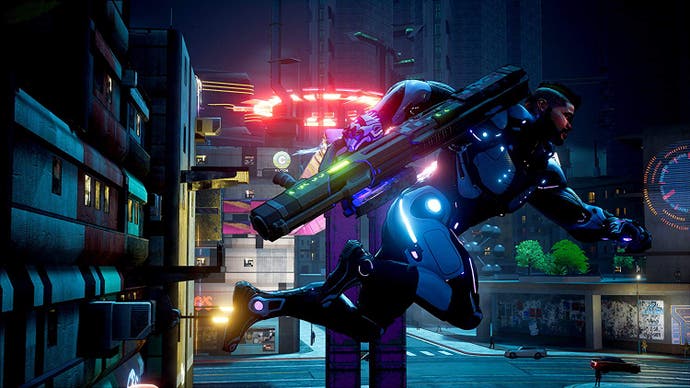
And this is where things start to go wrong for me. For one thing, the bosses are actually bosses, with their own arenas and monologues and all that jazz. They are uniformly unexciting, though, teleporting or stomping around in mechs, laying on one-hit death beams or flinging minions at you. I did not enjoy chugging through them, but I also missed the sort of democratic Petri dish that was the original Crackdown set-up, in which bosses are just normal baddies, albeit with bigger health bars and more armour. I liked the way they were the same size as everyone else, part of the swarm. It made for a game that never really wanted to interrupt you with structure, and which knew that the player, ultimately, diving in and out of an encounter as they saw fit, should ultimately be the one to decide what constituted a set-piece.
The bosses are also often accessed by crawling up giant super-scrapers, which is a Crackdown standard. Here, though, the real action takes place inside, as you fight your way across massive echoing chambers filled with baddies. Crackdown 3's arsenal, ranging from homing rockets to heat rays and a gun that fires nasty little toxic mines, is excellent, but faced with room after room of scurrying baddies, the game loses a little of its distinct flavour. Platforming, meanwhile, though often intricate, loses the vertiginous thrill that you got in the first Crackdown, where you climbed buildings more often than not by scaling the outsides, each one a mini-Pompidou Centre, committed to creating a pleasing jump-puzzle.
Before you even get to the bosses though, I think there's something wrong with the way Crackdown 3 generously pre-bakes little action encounters for you. By turning each neighborhood into a collection of nodes to be completed - jails to be busted, mining operations to be shut down, car lock-ups to be exploded - I ceased to see New Providence as a place in the same way as Pacific City had been. It became a list of things to be ticked off, a kind of fancy high-contrast spreadsheet. New Providence is frequently anonymised by its sheer utility. The roads, meanwhile, while tying nicely into some Evil Reyner Banham vision of the future, seemed a bit surplus to requirements given the gutless handling model of even the smartest agency vehicle. In the future, it seems, all cars will move like Dysons, which is bad enough. But many of them will actually sound like Dysons too.
(Roads as a means of obscuring poverty and keeping you moving round and round forever! Tenements obscured by antic light! Skyscrapers built on toxic shanties! This might be that rare open-world that is better at offering social satire than it is at conjuring entertaining playgrounds. Not that it's nailing satire all the time, mind. Every Crackdown game has struggled with the implications of the central fantasy, of being a super-powered authoritarian descending from the sky to kick people to ribbons and then move on. Despite a few jokes about Brexit and Trump's wall, Crackdown 3 remains incoherent on this front. It is clearly aware, at least, that there are problems inherent in a game that channels the potent thrill of being a bully.)
These nodes - the prisons, the mines, the lock-ups - all offer five minutes of Crackdown fun as you dive in and out of the action, over-reach and then get lucky with a last-second headshot. But even that seems a little less entertaining than it used to be.
Because of this - because I suspected that the game wasn't just competing with the first Crackdown, which seemed unfair enough, but with my memories of the first Crackdown - I went back to the original for an afternoon to see if it was actually as good as I thought it was, and to untangle the invisible things it seemed to do that Crackdown 3 didn't.
It's a funny experience. For one thing, right up-front, there is that single moment of fun that every Crackdown game since has tried to reclaim, ambered inside the logo for Realtime Worlds at the very start: a supercop diving from the sky, an explosion shaking the traffic and shredding the crowds as a flock of rewarding orbs gathers.
For another thing, I had forgotten that Pacific City prioritises space over complexity, and this feels very important to how it all unfolds.
I am fully prepared to be told that New Providence has a bigger footprint than Pacific City. But the important thing is that it doesn't feel like it does. New Providence is tangled and dense, slums built beneath super-scrapers, factories reaching out to smother town squares. The first Crackdown, though, gives you a lot of flatness at times, and a lot of space between different areas. This means that when you arrive somewhere new, it feels new. It also means that you can easily turn one gunfight into a cross-city disaster as you dive into a car and charm-bracelet a bunch of baddies halfway across the map in pursuit. I had forgotten about all of this, just as I had forgotten as one half of the game's starting island is essentially mountainous, offering peaks and valleys in which you can wander on your lonesome, now and then coming up across a radio tower or a lighthouse.
These are places that feel like places rather than icons on a map, and even after the baddies are taken out they feel like they tell a story about the landscape. In Crackdown 3, scattered installations perfect for the unleashing of five minutes of action each time theoretically tell an authoritarian story of their own, I guess, but they mainly seem to speak of game design: do this, then this, and then move onto that thing over there. Crackdown's peculiar sense of freewheeling flow, from one bad idea to another, from the curb of one sidewalk to the finial of a distant building, was delivered by what wasn't there as much as by what was: the game had the space to allow things to happen, and the precise context to allow you to remember it.
And speaking of context, it's worth bearing in mind that the first Crackdown's powerful appeal is almost inseparable from the Xbox 360. Part of Crackdown's genius, I think, was to understand that it could be an in-between game. Like one of those magic eye pictures where the image only resolves once you learn to look through it, looking through the first Crackdown brought so many other things about its era into focus, the counter-rule prodding of Achievements, the 360 dash, less a games machine - often it visibly struggled to be a games machine - and more a sweet migraine-coloured dorm where all your friends hung out waiting to drop into a game with you. Crackdown fit perfectly into this place, the missing piece between five minutes of Geometry Wars, say, and a proper evening lost to Halo 3. Everything was progress, and you leapt in with no threads to remember, no gatekeeping, nothing to get in the way of mindless daydreamy fun. On the 360, games flowed into one another more than they ever had before.
All of this, and I appreciate how unfair this is, makes it almost impossible for me to take Crackdown 3 purely on its own terms. Even when I clear my mind and try to focus on what's actually here, I'm drawn back to the original game. Even so, yesterday evening, with the rest of the house asleep and my professional obligation to Wrecking Zone completed, I went back into the campaign, bosses all gone, map largely swept clean of icons, to see if I could fall in love with New Providence.
It was night when I emerged from a supply point at the Outlands and retraced my journey around the city, before heading inwards to the super-scrapers. The buildings were industrial slabs of darkness picked out with lurid bars of neon. Sure, I could see the neighborhoods a little more clearly now they weren't simply receptacles for the objectives neatly stored on each street corner. Equally, there was fun to be had hopping from roof to roof and picking off Agility Orbs, drawn by that throbbing, humming ringing sound and those shafts of green light.
But the more I moved around the city, the more I traded slums for chemical plants and pleasure domes, the more I felt like I wasn't really moving enough, because the city had chosen complex geometry rather than any kind of meaningful variety. The map refused to become a place.
I will return here for the next few evenings and hit the 750 Orb cap, but I won't stay past that, I suspect. Seemingly simple as it was, Crackdown's first city always felt like it had further secrets hidden away, things that I had not yet encountered. This one, clever as it is, already feels picked clean.
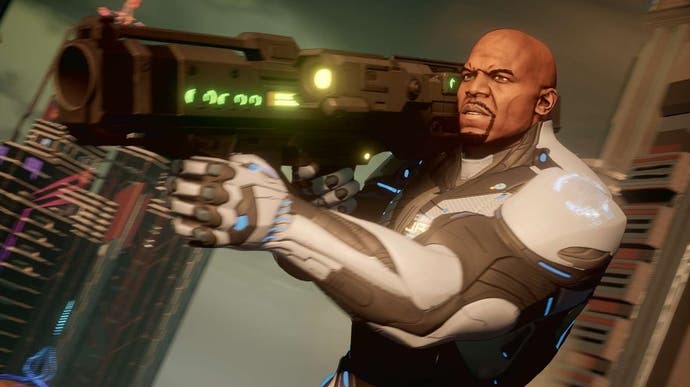



.jpg?width=291&height=164&fit=crop&quality=80&format=jpg&auto=webp)
